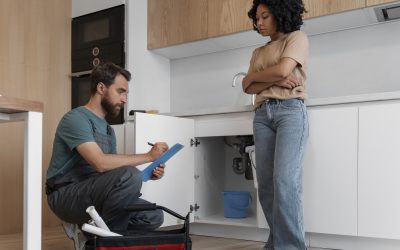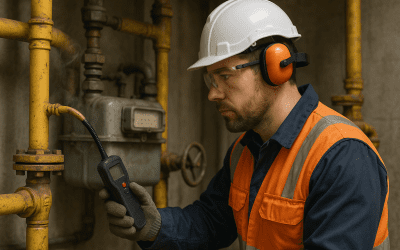So, how do you know when it’s time for sewer line replacement? That’s exactly what we’re about to explore in this blog. Continue reading!
Signs | It’s High Time for Sewer Line Replacement
Foul Odors Around The Property
If you keep noticing a persistent sewage smell around your home or yard, it’s a clear warning sign of a damaged sewer line. That unpleasant odor usually means raw sewage is leaking through cracks or breaks in the pipe and seeping into the soil. Beyond being unpleasant, sewer gases like hydrogen sulfide can also pose health risks. So, if the odor won’t go away despite regular plumbing upkeep, it’s probably time to consider a full sewer line replacement to fix the issue for good.
Multiple Joint Separations Or Fractures Along The Pipe
Frequent joint separations or recurring fractures in your sewer line point to a systemic issue, not just isolated wear and tear. These problems often arise from aging materials like clay or cast iron, which naturally degrade over time or shift due to soil movement. When an inspection uncovers multiple compromised joints, it signals that the entire system has become unstable. At that stage, patching individual sections is no longer a practical solution—it’s just a costly, temporary fix.
Lush, Green Patches In Your Yard
Unusually fast-growing patches of grass can be a subtle but serious sign of a failing sewer line. When underground pipes crack or break, they leak nutrient-rich wastewater into the soil. That water acts like fertilizer and causes the grass in that area to grow faster and look greener than the rest. It’s a sign that sewage is seeping into the soil below. While this may seem harmless initially, it often indicates the need to call a professional for a full inspection or replacement before things worsen.
Mold Or Mildew Inside The Home
As underground pipes age or become damaged, moisture can start to build up beneath your foundation. Eventually, it seeps into your home, creating the perfect damp conditions for mold to grow. If this mold keeps showing up in the same spots, no matter how thoroughly you clean, it’s a strong sign that water is coming in from below, most likely due to a broken sewer line. In that case, the only real fix may be a full sewer line replacement.
Large Sinkholes Or Depressions Forming In The Yard
When a sewer pipe collapses or leaks heavily underground, it can wash away the surrounding soil and weaken the ground above. Over time, this missing support creates hollow pockets, eventually leading to visible depressions or holes, which threaten your home’s foundation and pose real safety risks. Patching this surface won’t work if the underlying pipe keeps eroding the soil.
Visible Cracks Or Structural Breaks In The Sewer Camera Inspection
Sewer camera inspections give you a clear view inside your pipes, and if the footage shows cracks, fractures, or even collapsed sections, that’s a strong sign the line needs to be replaced. These kinds of structural issues can seriously affect how well your plumbing system works, causing slow drains, backups, or even leaks. While small problems might be fixable, repairs usually aren’t enough if the damage is widespread. At that point, the pipe is likely too far gone for patchwork solutions.
Structural Pipe Damage Causing Recurring Drainage Issues
Persistent clogs, slow drainage, and backups shortly after cleaning often point to a more serious structural issue within the pipe, such as a sag or “belly” that traps waste and prevents proper flow. Even if snaking or cleaning provides temporary relief, the problem will continue to recur because the pipe’s alignment or integrity is compromised. In such cases, standard cleaning methods are ineffective, and a full pipe replacement may be necessary to resolve the issue permanently.
Prime Reasons For Home Sewer Line Deterioration
-
Age of the Sewer Line
Every sewer line has a lifespan. Pipes made from clay, cast iron, or Orangeburg (a tar paper product) were commonly used in homes built before the 1970s. These materials naturally degrade over time due to constant exposure to moisture, waste, and soil pressure. As the decades pass, the inner walls become brittle, corrode, or form cracks. Once the structural integrity is compromised, the line can no longer function efficiently, often leading to complete failure. Even if no symptoms are showing yet, older systems should be evaluated proactively to prevent sudden breakdowns.
-
Tree root Infiltration
Tree roots are one of the most aggressive and damaging threats to underground sewer pipes. Roots are drawn to the moisture and warmth escaping from tiny cracks or loose joints in sewer lines. Once a root finds a way in, it expands inside the pipe, forming dense root balls that block flow and exert outward pressure. In older clay or concrete lines, roots can even force pipes apart, leading to fractures and water leakage into the surrounding soil. This issue tends to worsen over time, particularly in properties with large or fast-growing trees near the sewer route.
-
Shifting soil
Changes in the ground around your sewer line can have a serious impact on its condition. Events like nearby excavation, erosion from poor drainage, or even natural settling of the earth over time can cause the soil to shift or sink. When this happens, the pipe may become unsupported or develop stress points. This movement can cause misalignment in joints, create pipe bellies (low spots where waste collects), or even crack the line altogether. The more unstable the soil, the higher the risk of these types of structural failures.
-
Improper Installation
The way your sewer line was originally installed plays a big role in its long-term durability. If the pipe was laid with incorrect slope (too steep or too flat), waste may not flow properly, causing repeated blockages and excessive pressure inside the system. Poor sealing at the joints, inadequate bedding material, or using the wrong pipe size are other common installation errors. These problems may not show up immediately, but over time, they weaken the entire system, leading to leaks, joint separations, and early deterioration that may require full replacement to fix.
-
Frequent Use of Chemical Drain Cleaners
While chemical drain cleaners can temporarily relieve clogs, they do more harm than good in the long run. Most of these products contain highly corrosive ingredients like sodium hydroxide or sulfuric acid, which are designed to dissolve hair, grease, and soap scum. Unfortunately, these chemicals also eat away at the inside of your sewer pipe. Repeated exposure causes corrosion in metal pipes and weakens plastic ones, making them more susceptible to cracks or collapses. Over time, even occasional use can cause serious internal damage.
-
Improper Waste Disposal
Many homeowners unknowingly contribute to sewer line wear and tear through what they send down the drains. Pouring cooking grease, fats, or oils into the kitchen sink can cause it to solidify in the pipes, creating stubborn clogs. Similarly, flushing items like baby wipes, sanitary products, and paper towels—even those labeled “flushable”—can lead to blockages that increase pressure on the pipe walls. This added stress over time causes pipes to stretch, crack, or separate at the joints. A build-up of waste also slows water flow, which accelerates wear on the interior lining.
What Our Professionals Can Do For You
Dealing with recurring sewer line issues can be frustrating, especially when quick fixes don’t last. In this situation, you can get help from our experts. At Local Plumbing LLC, we provide a free camera inspection to locate the real problem and offer a free estimate for a sewer line replacement or repair. Our experienced plumbers in Cibolo and New Braunfels handle all types of plumbing needs, including toilet rebuilds, leak repairs, sump pumps, water heaters, tankless systems, water softeners, and carbon filters.No matter the job, you can count on us for honest advice, dependable service, and clear communication every step of the way. Call us at (210) 803-0662 or email Justin@LocalPlumbingLLC.net — we’re here to help.




